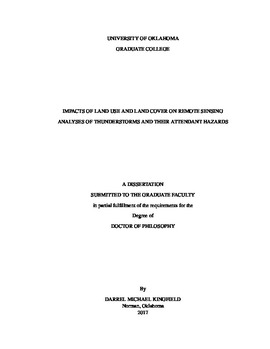| dc.description.abstract | Due to their hazardous nature, most thunderstorm observations today come from remote sensing platforms such as radar, satellite, and lightning detection sensors. Advancements in these sensor networks provide the ability to identify and track thunderstorms at finer spatial and temporal scales than ever before. Thunderstorms, however, are products of interactions between the land and atmosphere with certain land use and land cover (LULC) types augmenting the frequency and intensity of thunderstorms. Yet, these LULC effects may not be directly apparent when examining the remote sensing fields in isolation. This dissertation represents three research endeavors, each containing a multi-year climatology of a unique remote sensing dataset, to examine how the addition of LULC information affects the identification of thunderstorms and their attendant hazards and the interpretation of remote sensing products.
First, a 20-year climatology of cloud-to-ground (CG) lightning data at 500 m spatial resolution quantifies an increase in isolated regions of high CG lightning frequencies in concert with the construction of antenna towers to accommodate the expansion of broadcasting and telecommunications technologies across the United States. CG lightning occurrence is correlated with antenna height and 96% of towers examined had a higher lightning density with 1 km of a tower compared to 2 km to 5 km away. Comparing tower strikes in the northern Great Plains reveals that shorter towers are more likely to observe larger CG lightning densities in the meteorological winter/fall months compared to the spring/summer months.
Second, a five-year multi-radar/multi-sensor retrospective examining the effects of city size on thunderstorm initiation and longevity reveals an increase in thunderstorm frequency downwind of both cities larger than 1100 km^2 on convective days with ingredients historically shown to be conducive for urban-enhancement (i.e., summer months, afternoon initiation, synoptically weak days, non-supercell modes). As a result, downwind regions experienced a higher frequency of more intense composite reflectivity, vertically integrated liquid, and maximum expected size of hail values compared to equivalent distances upwind. Such effects were not observed in the smaller two cities and were not observed in any of the cities when examining the full five-year dataset.
Finally, Landsat 5 Thematic Mapper and Landsat 7 Enhanced Thematic Mapper Plus surface reflectance data were acquired to examine how tornadoes alter the spectral behavior of grassland, forest, and urban land cover. Generally, independent of land cover type, tornadoes tend to increase the surface reflectance in the visible and shortwave-infrared spectral bands and decrease surface reflectance as measured within the near-infrared (NIR) spectral band. This results in a higher tasseled cap brightness, lower tasseled cap greenness and wetness, and a lower Normalized Difference Vegetation Index (NDVI) values. With tornado damaged forests providing an analogous signature to forest clearing, a five-year climatology of Landsat imagery was acquired to compare NDVI, a common damage identification metric derived from the red and NIR spectral bands, to a disturbance index (DI) derived from the tasseled cap indices to examine tornado damage in forests. DI is more resilient to seasonal variability as its coefficients are derived on an image-by-image basis, making it an optimal metric for a pixel-based identification and tracking of damage and subsequent recovery. | en_US |
